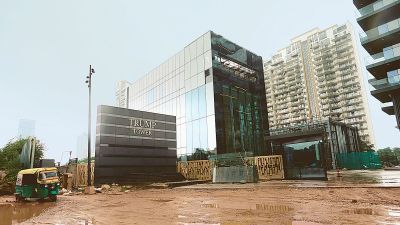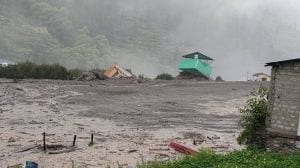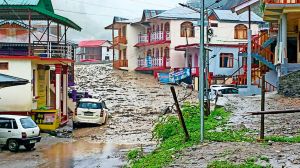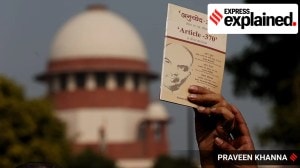UPSC Key: Jal Jeevan Scheme, e-Zero FIR, and genetically modified products
Why is the e-Zero FIR initiative of I4C relevant to the UPSC exam? What is the significance of topics such as genetically modified (GM) products, core inflation rate, UNSC have on both the preliminary and main exams? You can learn more by reading the Indian Express UPSC Key for May 20, 2025.
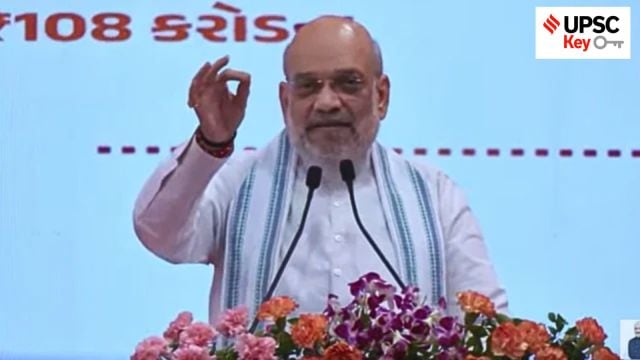 UPSC Key 20th May 2025: Amit Shah said the I4C, which comes under the Ministry of Home Affairs, has introduced the new e-Zero FIR initiative to nab any criminal with unprecedented speed.
UPSC Key 20th May 2025: Amit Shah said the I4C, which comes under the Ministry of Home Affairs, has introduced the new e-Zero FIR initiative to nab any criminal with unprecedented speed.Important topics and their relevance in UPSC CSE exam for May 20, 2025. If you missed the May 19, 2025, UPSC CSE exam key from the Indian Express, read it here.
FRONT
After cost overrun, Govt to send 100 teams to ‘inspect’ Jal Jeevan schemes
Syllabus:
Preliminary Examination: Current events of national and international importance
Mains Examination: General Studies-II: Government policies and interventions for development in various sectors and issues arising out of their design and implementation
What’s the ongoing story: THE GOVERNMENT has decided to send 100 teams of Central Nodal Officers for “ground inspection” of the Jal Jeevan Mission schemes across the country. The move follows a meeting chaired by the Cabinet Secretary on May 8 to review the mission’s schemes.
Key Points to Ponder:
— What is the Jal Jeevan Mission?
— What are the challenges related to JJM?
— Why government decide to review the mission’s schemes?
— How is the finance for this scheme distributed between the Center and the state?
Key Takeaways:
— The order issued by the Department of Personnel and Training on Monday identified 99 nodal officers to inspect as many as 183 schemes across 135 districts in 29 states and Union Territories.
— The decision for a review comes two months after an Expenditure Secretary-led panel proposed a 46 per cent cut to the Water Resources Ministry’s proposal demanding Rs 2.79 lakh crore for completing the mission over four years ending December 2028.
— The GOVERNMENT has taken note of the escalation in costs towards providing tap water connections across states ruled by different political parties. A ‘ground inspection’ of work orders in different places will give a picture not just of the costs involved in executing the job, but also the quality of work.
— Since the launch of the Jal Jeevan Mission in 2019, 6.4 lakh water supply schemes with total estimated cost of Rs 8.29 lakh crore—more than double of the scheme’s original outlay of Rs 3.60 lakh crore (Centre: Rs 2.08 lakh crore, States:1.52 lakh crore) — have been approved by the states.
Do You Know:
— The Jal Jeevan Mission, launched by Prime Minister Narendra Modi on August 15, 2019, aimed to provide tap connections to about 16 crore rural households to achieve saturation coverage by December end 2024.
— But only 75 per cent of the target could be achieved over five years, and the remaining 4 crore tap connections are now proposed to be installed by extending the mission by four years till December 31, 2028.
— Amit Kumar Srivastwa writes: The recent NSSO data suggests that the government has made significant progress, as almost 90 per cent of rural households have access to a tap connection. However, there is a wide gap between tap water access and use, as only 39 per cent of the rural households can use taps as their primary source (NSS 79th Round, 2022-23).
— There are also structural challenges. Reports by this newspaper reveal a reduction in financial assistance by the central government, bureaucratic irregularities at the state level, and scams in constructing JJM’s infrastructure, which has slowed down JJM’s progress.
— There is an urgent need to strengthen the grievance redressal channels and mechanisms. No data is available on how many grievances are received and solved by the local-level actors.
Other Important Articles Covering the same topic:
📍Many challenges of Jal Jeevan Mission: Decentralisation is the only way ahead
Prelims Question Covering similar theme:
(1) Consider the following statements:
1. The Jal Jeevan Mission was launched in 2022.
2. Water is a matter included in the State list in the seventh schedule of the Indian Constitution.
Which of the statements given above is/are correct?
(a) 1 only
(b) 2 only
(c) Both 1 and 2
(d) Neither 1 nor 2
Latvia, Congo: India outreach to members of UNSC, now and future
Syllabus:
Preliminary Examination: Current events of national and international importance
Mains Examination: General Studies-II: Bilateral, regional, and global groupings and agreements involving India and/or affecting India’s interests. Important International institutions, agencies, and fora- their structure, mandate.
What’s the ongoing story: India’s multi-party outreach to rally global support for its war against terror emanating from Pakistan is not just aimed at major countries and the West Asian region, but also at countries that will be members of the UN Security Council (UNSC) next year.
Key Points to Ponder:
— What is the UNSC? Why was it formed?
— What is the composition of the UNSC?
— Read about OIC, G7, and BRICS
— Why is the government pursuing multi-party outreach to rally global support for its war against terror?
— How significant is this move?
— Which countries are the members of the OIC?
— What is the role of the UNSC in countering terrorism?
— Why is there a growing demand for reforming the UNSC?
Key Takeaways:
— Latvia, Democratic Republic of Congo (DRC), Bahrain, Liberia and Colombia will be part of the UNSC for a two-year period from January 1, 2026 till December 31, 2027.
— Pakistan is a non-permanent member of the UNSC in 2025-2026. As part of its efforts to isolate Islamabad internationally, India wants to convey its concerns about Pakistan’s support to terror groups and terror infrastructure.
— The teams will go to countries which are permanent members of the UNSC — the US, UK, France and Russia, but leaving out China, which is seen as an all-weather friend and a benefactor of Pakistan.
— Among the non-permanent members, they will tour countries whose terms expire in December this year — Algeria, Guyana, Republic of Korea, Sierra Leone and Slovenia – as well as the countries which will replace them next January.
— India’s outreach to the UNSC members (both current and incoming) is important. Delhi and Islamabad had a face-off when the UNSC statement was negotiated in New York after the Pahalgam terror attack — Pakistan had the advantage of being a current non-permanent member.
— The teams will also visit key Muslim-majority countries in West Asia and South East Asia — Saudi Arabia, UAE, Qatar, Egypt, Kuwait, Indonesia and Malaysia. These are all prominent members of the OIC grouping and once-strong supporters of Pakistan – they have become more pragmatic and positive on their ties with India.
— Barring Canada, with which relations are still in the process of being repaired, the teams are also going to the remaining G7 countries — Germany, Italy, Japan and the European Union. Spain is also added as an important European partner country, which is usually invited for the G20 summit.
— Brazil and South Africa have been included as important BRICS partner countries, as well as G20 members. Ethiopia has been included as it hosts the African Union’s headquarters. Singapore, also a major partner country, is located at the information hub of the South-East Asian region.
Do You Know:
— The United Nations (UN) came into existence on 24 October 1945, after being ratified by 51 nations, which included five permanent members or P5 (France, the Republic of China, the Soviet Union, the UK and the US) and 46 other signatories. The first meeting of the General Assembly took place on January 10, 1946. At present, 193 countries are members of the United Nations.
— The UN Charter established six main organs of the United Nations, including the UN Security Council (UNSC). The UNSC held its first session on 17 January 1946 at Church House, Westminster, London. Since its first meeting, the Security Council has taken permanent residence at the United Nations Headquarters in New York City.
— The UNSC is composed of 15 members: five permanent members — China, France, Russian Federation, the United States, and the United Kingdom — and 10 non-permanent members who are elected by the General Assembly. The non-permanent members are elected for two-year terms — so every year, the General Assembly elects five non-permanent members out of the total 10.
Other Important Articles Covering the same topic:
📍Knowledge Nugget: Why are BRICS and New Development Bank important for UPSC exam?
UPSC Prelims Question Covering similar theme:
(2) The Security Council of the UN consists of 5 permanent members, and the remaining 10 members are elected by the General Assembly for a term of ( UPSC CSE 2009)
(a) 1 year
(b) 2 years
(c) 3 years
(d) 5 years
UPSC Mains Question Covering similar theme:
Discuss the impediments India is facing in its pursuit of a permanent seat in the UN Security Council (UPSC CSE 2015)
GOVT & POLITICS
New e-Zero FIR for swift probe, crackdown on cyberfauds: Amit Shah
Syllabus:
Preliminary Examination: Current events of national and international importance
Mains Examination: General Studies-III: Challenges to internal security through communication networks, role of media and social networking sites in internal security challenges, basics of cyber security; money-laundering and its prevention.
What’s the ongoing story: UNION HOME Minister Amit Shah on Monday said they have introduced the new e-Zero FIR that automatically converts cyber financial crime complaints with a cheating value above Rs 10 lakh, registered on the 1930 helpline or the National Cybercrime Reporting Portal (NCRP), into FIRs.
Key Points to Ponder:
— What is cyber fraud?
— How is India vulnerable to cyber fraud?
— What are the different types of cyber threats?
— What are the steps taken by the government to counter cyber fraud?
— What is the Indian Cyber Crime Coordination Centre (I4C)?
— What do you understand by ‘cyber-secure Bharat’?
Key Takeaways:
— Shah said the Indian Cyber Crime Coordination Centre (I4C), which comes under the Ministry of Home Affairs, has introduced the new e-Zero FIR initiative to nab any criminal with unprecedented speed.
— In his post on X, Shah said the new system, which has been launched as a pilot project for Delhi, will automatically convert cyber financial crimes filed at NCRP or 1930 to FIRs, initially above the threshold limit of Rs 10 lakh.
— An official said the process of issuing FIRs electronically, irrespective of territorial jurisdiction, will soon be extended to the entire nation. This initiative will enable easy restoration of money lost by victims and facilitate punitive action against cybercriminals. It leverages the provisions of the recently introduced criminal laws, an official statement said.
— Shah had given instructions for the implementation of this initiative in a recent review meeting of I4C, keeping in view the difficulties faced by victims of cyber financial crimes in the recovery of the money lost.
— The NCRP and 1930 helpline have enabled easy reporting and prompt action on complaints related to cyber financial crimes.
— The Delhi police and I4C have worked together to put in place a process for registration of cases in accordance with the new provisions of Section 173 (1) and 1(ii) of Bhartiya Nagrik Suraksha Sanhita.
Do You Know:
— The I4C, established in 2018, is a department under the Ministry of Home Affairs (MHA) tasked with establishing a national-level coordination centre to address cybercrime-related issues
— A massive surge in cybercrime incidents was reported in India with fraudsters cheating people of Rs 33,165 crore in the last four years, including Rs 22,812 crore in 2024, with several Tier 2 and 3 cities identified as cybercrime hotspots, shows government data.
— Data compiled by the National Cyber Reporting Platform (NCRP), under the Ministry of Home Affairs, shows fraudsters cheated people of Rs 551 crore in 2021, Rs 2,306 crore in 2022, and Rs 7,496 in 2023.
— Data also shows that 1,37,254 complaints were received in 2021, 5,15,083 in 2022, 11,31,649 in 2023, and 17,10,505 complaints were received last year.
Other Important Articles Covering the same topic:
📍Rs 11,333 crore lost in just 9 months: A look at the cyber scams that have hit India the worst
Previous year UPSC Prelims Question Covering similar theme:
(3) In India, it is legally mandatory for which of the following to report on cyber security incidents? (UPSC CSE 2017)
1. Service providers
2. Data centres
3. Body corporate
Select the correct answer using the code given below:
(a) 1 only
(b) 1 and 2 only
(c) 3 only
(d) 1, 2 and 3
Previous year UPSC Mains Question Covering similar theme:
What are the different elements of cyber security ? Keeping in view the challenges in cyber security, examine the extent to which India has successfully developed a comprehensive National Cyber Security Strategy. (2022)
THE IDEAS PAGE
The future is bilingual
Syllabus:
Preliminary Examination: Current events of national and international importance
Mains Examination: General Studies-II: Government policies and interventions for development in various sectors and issues arising out of their design and implementation
What’s the ongoing story: Peggy Mohan writes: This year, 2025, is the year that I am seeing the most energy thrown into translation, with books originally written in English coming out in major Indian languages. This interest is new, and it doesn’t look like just a whim in the heads of publishers.
Key Points to Ponder:
— What do you understand by bilingual textbooks?
— What is Diglossia?
— What is Macaulay’s minutes on education?
— What are the issues in the Indian education system?
— What steps have been taken by the government?
— What do you know about the New Education Policy (NEP)?
— What are the challenges in implementing the NEP?
Key Takeaways:
— What is most exciting is that this is not government policy: It is ordinary people taking the initiative. All of a sudden, I am being asked to do talks, podcasts, and even launch my new book in Hindi, to lecture in Urdu, while I am assured that I can “mix in English” if I get stuck. I am being invited to step out of the rut of diglossia and expand the scope of our languages.
— Diglossia is a kind of bilingualism where two or more languages do not duplicate each other, but play very different roles. There is a “high” language, for important things, and a “low” language for speaking to children, the poor and about things closer to the ground.
— Being invited to close the gap by giving more technical talks in an Indian language is exciting, as it reduces the need for English while, paradoxically, allowing into our languages new words from English for things they were not previously talking about.
— We have seen this sort of moment before. The last time was in the twelfth century, an age when large parts of the Subcontinent were ruled by elites who spoke Prakrit and patronised literature in Sanskrit… while the Prakrits themselves stayed within the ruling class — a source of vocabulary but not really available to ordinary people. Then, as the Prakrit kingdoms fell, and the modern North Indian languages emerged into the sunlight, the Prakrits themselves went extinct.
— Is there a way for us to seize this moment and bring in another Golden Age? I think there is… What would set this right is bilingual textbooks, where everything is recapped in a language the teacher and the children know well. Once they know what it is about, they can easily discuss the lesson and clear doubts…
— It may come as a surprise to people nowadays to learn that one person who thought Indian “boys” should be educated in the home language until Class 8 was Macaulay. The only disruptive part of his plan was his belief that Indian “boys” wanting to go into science should transition to English-medium schooling at that point.
Do You Know:
— An NEP is a comprehensive framework to guide the development of education in the country. The need for a policy was first felt in 1964 when Congress MP Siddheshwar Prasad criticised the then government for lacking a vision and philosophy for education.
— The same year, a 17-member Education Commission, headed by then UGC Chairperson D S Kothari, was constituted to draft a national and coordinated policy on education. Based on the suggestions of this Commission, Parliament passed the first education policy in 1968.
— The National Education Policy, 2020 is the third national education policy of the country. The first came in 1968 and the second in 1986, under Indira Gandhi and Rajiv Gandhi respectively; the NEP of 1986 was revised in 1992 when P V Narasimha Rao was Prime Minister. The third NEP is released under the Prime Ministership of Narendra Modi.
— The NEP proposes sweeping changes including opening up of Indian higher education to foreign universities, dismantling of the UGC and the All India Council for Technical Education (AICTE), introduction of a four-year multidisciplinary undergraduate programme with multiple exit options, and discontinuation of the M Phil programme.
— The NEP says students until Class 5 should be taught in their mother tongue or regional language.
Other Important Articles Covering the same topic:
📍Explained: India’s National Education Policy, 2020
📍Centre vs Tamil Nadu: We are having the wrong debate about language
Previous year UPSC Prelims Question Covering similar theme:
(4) Which of the following provisions of the Constitution does India have a bearing on Education? (2012)
1. Directive Principles of State Policy
2. Rural and Urban Local Bodies
3. Fifth Schedule
4. Sixth Schedule
5. Seventh Schedule
Select the correct answer using the codes given below:
(a) 1 and 2 only
(b) 3, 4 and 5 only
(c) 1, 2 and 5 only
(d) 1, 2, 3, 4 and 5
EXPLAINED
Why Supreme Court struck down the Centre’s orders on retrospective environmental clearances
Syllabus:
Preliminary Examination: General issues on Environmental Ecology, Biodiversity and Climate Change – that do not require subject specialisation
Mains Examination: General Studies-III: Conservation, environmental pollution and degradation, environmental impact assessment
What’s the ongoing story: The Supreme Court on Friday (May 16) struck down and held illegal a 2017 notification of the Ministry of Environment, Forest and Climate Change (MoEF&CC), which introduced a regime of granting ex-post facto clearances to projects – after work had already begun. The judgment followed a clutch of petitions challenging the notification.
Key Points to Ponder:
— What is the Environment Impact Assessment (EIA) notification of 2006?
— What is the objective of EIA?
— What was the rationale behind the 2017 notification?
— Learn about various SC judgements related to environmental protection, including the M.C. Mehta case
— How do constitutional provisions provide for the protection of the environment?
— Environment protection and development can co-exist – what is your opinion?
— How has the Supreme Court broadened the scope of Article 21?
— Know about these judgments: Common Cause v. Union of India (2017) and Alembic Pharmaceuticals v. Rohit Prajapati (2020)
Key Takeaways:
— Additionally, the SC judgment set aside a 2021 office memorandum, which introduced a standard operating procedure for streamlining the grant of post facto clearances. The judgment also restrained the Centre from issuing similar notifications or office orders for regularising acts violating the Environment Impact Assessment (EIA) notification of 2006.
— In March 2017, the MoEF&CC issued a notification providing a “one-time” six-month window for industries to apply for environmental clearance. It was applicable if they had begun operations, expanded production beyond what they were permitted or changed their product mix without obtaining prior clearance.
— Notably, a prior clearance is mandatory under the EIA notification, 2006, to scrutinise a project’s impact on the environment, natural resources, human health and social infrastructure (such as schools and hospitals).
— The bench of Justice Abhay S Oka and Justice Ujjal Bhuyan rapped the Centre for issuing OMs “to protect those who have caused harm to the environment”, and questioned whether development can happen at the cost of the environment.
— It said that the Centre went out of its way to protect those causing harm to the environment, and that the court cannot allow such attempts, as it has the constitutional and statutory mandate to uphold Article 21 (right to protection of life and personal liberty).
— In the past, the apex court has broadened the scope of Article 21 to include the right to a healthy and pollution-free environment. It held the 2017 notification and 2021 OM in violation of Article 21 and Article 14 (right to equality before law), as the OM was for all project proponents who “were fully aware” of the consequences of violations.
— The bench cited two past judgments – Common Cause v. Union of India (2017) and Alembic Pharmaceuticals v. Rohit Prajapati (2020) – to reaffirm that ex-post facto clearances were alien to environmental law.
— It came down heavily on the Centre for violating these orders through the 2021 OM, which essentially regularised the illegality of commencing a project construction without prior clearance.
— In the Alembic case, a bench of Justice Chandrachud and Justice Ajay Rastogi had said that the concept of an ex-post facto was in derogation of fundamental principles of environmental jurisprudence, and an anathema to the EIA notification.
Do You Know:
What’s fuelling deforestation
— The situation appears grimmer when viewed against the backdrop of accelerated industrialisation and urbanisation, which are the primary reasons behind forest degradation. India lost around 1,73,300 hectares of forest areas due to development projects between 2014-15 to 2023-24, according to the Union Environment Ministry.
— In mineral-rich states like Chhattisgarh, Jharkhand and Odisha, extensive mining has been the leading cause of substantial forest loss, with over 1 lakh hectares of forestland diverted for around 500 mining projects until 2018.
— In hilly areas of the northeast, shifting cultivation (Jhum), agriculture expansion, and extensive logging are the primary factors behind the loss of green cover. This made Arunachal Pradesh, Manipur, Nagaland, etc., states with the largest loss of forest cover between 2021-2023.
— Apart from this, the increasing forest fire, often triggered by human activity and prolonged dry spells, leads to further forest degradation. Climate change intensifies this risk by creating warmer and drier conditions.
— Between November 2023 and June 2024, the Forest Survey of India recorded 2,03,544 forest fire incidents. Such alarming trends underscore the urgent need for a strong and responsive legal framework to protect forest ecosystems.
Other Important Articles Covering the same topic:
📍Rapid development, shrinking green cover: Why forest conservation cannot wait
📍Before doors closed, 55 projects benefited from 2017-2021 environmental amnesty
UPSC Prelims Question Covering similar theme:
(5) Consider the following statements: The Environment Protection Act, 1986 empowers the Government of India to (2019)
1. state the requirement of public participation in the process of environmental protection, and the procedure and manner in which it is sought
2. lay down the standards for emission or discharge of environmental pollutants from various sources
Which of the statements given above is/are correct?
(a) 1 only
(b) 2 only
(c) Both 1 and 2
(d) Neither 1 nor 2
UPSC Mains Question Covering similar theme:
How does the draft Environment Impact Assessment (EIA) Notification, 2020 differ from the existing EIA Notification, 2006? (2020)
The ‘core’ of inflation, and RBI’s rate cutting decisions
Syllabus:
Preliminary Examination: Economic and Social Development – Sustainable Development, Poverty, Inclusion, Demographics, Social Sector Initiatives, etc.
Mains Examination: General Studies-III: Indian Economy and issues relating to planning, mobilisation, of resources, growth, development and employment
What’s the ongoing story: Between February 8, 2023 and February 6, 2025, the Reserve Bank of India (RBI) kept its key short-term ‘repo’ lending rate for banks unchanged at 6.5%.
This roughly two-year period (February 2023 to January 2025) saw inflation based on the official consumer price index (CPI) average 5.2% year-on-year. It was even higher, at 7.6%, for the consumer food price index (CFPI).
Key Points to Ponder:
— What is the consumer price index (CPI)?
— How is it different from core inflation?
— How is the inflation calculated?
— What is the consumer food price index (CFPI)?
— What is the role of the RBI’s monetary policy committee?
— What are the reasons for increased food inflation?
— How do supply-side shocks impact food inflation?
— “Union Minister Piyush Goyal had stated that it was an “absolutely flawed theory” to consider food inflation while deciding on interest rates.” Ponder on this.
— What is El Niño?
— What are anti-dumping duties?
— Read about: Repo rate, reverse repo rate, bank rate, headline inflation,
Key Takeaways:
— At the same time, the so-called core inflation rate – which excludes food and fuel items from the CPI to compute the annual price increase – was only 4.1%. The relatively low ‘core’ inflation was cited by many, then, as reason enough for the RBI’s monetary policy committee to cut interest rates.
— Food and fuel inflation are largely driven by supply-side factors – such as rainfall, temperature and other weather-related phenomena affecting crop output or geopolitical developments and production policies of major petroleum exporting nations.
— Given the inherently volatile nature of food and fuel inflation – which monetary policy cannot effectively address, as interest rates primarily work by influencing borrowing costs and aggregate demand in the economy – the RBI, it was argued, should focus on ‘core’ than the headline ‘general’ CPI inflation.
— While RBI has since reduced its repo rate, by 0.25 percentage points each on February 7 and April 9 to 6%, the pressure to do so came earlier. Union Commerce and Industry Minister Piyush Goyal had, on November 14, stated that it was an “absolutely flawed theory” to consider food inflation while deciding on interest rates.
— India experienced two major episodes of food inflation in the last three years. Both were courtesy of supply-side shocks. The first was Russia’s invasion of Ukraine in late-February 2022 that pushed up international agri-commodity prices.
— Even as the global supply disruptions from ‘war’, causing imported food inflation, eased towards early 2023, there came a second shock. This one had to do with ‘weather’, more specifically an El Niño event from around April 2023 to May 2024.
Do You Know:
— Inflation refers to the rate at which the general price level for goods and services increases over a period of time, causing a decrease in purchasing power of money or real income. In other words, as inflation rises, each unit of currency can buy fewer goods and services than before.
— Rising inflation affects the financial well-being of households, especially those with lower incomes or fixed incomes. As the cost of goods and services increases, it reduces the quantity of goods and services that can be purchased with the same nominal income, thereby affecting households’ cost of living.
— There are different methods for measuring inflation such as Consumer Price Index (CPI), Wholesale Price Index (WPI), GDP deflator, Producer Price Index (PPI), and wage inflation, with each focusing on a specific aspect of price changes.
— Typically, inflation relates to consumer prices of all goods purchased by the consumer which may be either domestically produced or imported. The government publishes CPI each month. CPI measures changes over time in the general level of prices of goods and services that households purchase for consumption.
The formula for calculating inflation is ((CPI x+1 – CPI x )/CPI x ))*100.
CPI x = the value of the CPI in the initial/base year x.
— The government releases the annual inflation rate figures every year. The annual inflation rate is calculated by measuring a year-on-year change in CPI, that is, the current month CPI over the CPI of the same month in the previous year. The percentage increase in this index over 12 months indicates the rate at which prices have risen.
— The Ministry of Statistics and Programme Implementation (MoSPI) calculates and publishes the CPI for the entire country as well as for the individual states.
Other Important Articles Covering the same topic:
📍How inflation affects cost of living
📍Balancing the care and monetised economies for India’s growth
Previous year UPSC Prelims Question Covering similar theme:
(6) With reference to the Indian economy, consider the following statements: (2022)
1. If the inflation is too high, Reserve Bank of India (RBI) is likely to buy government securities. 2. If the rupee is rapidly depreciating, RBI is likely to sell dollars in the market.
2. If interest rates in the USA or European Union were to fall, that is likely to induce RBI to buy dollars.
Which of the statements given above are correct?
(a) 1 and 2 only
(b) 2 and 3 only
(c) 1 and 3 only
(d) 1, 2 and 3
(7) Consider the following statements: (UPSC CSE 2020)
1. The weightage of food in Consumer Price Index (CPI) is higher than that in Wholesale Price Index (WPI).
2. The WPI does not capture changes in the prices of services, which CPI does.
3. Reserve Bank of India has now adopted WPI as its key measure of inflation and to decide on changing the key policy rates.
Which of the statements given above is/are correct?
(a) 1 and 2 only
(b) 2 only
(c) 3 only
(d) 1, 2 and 3
ECONOMY
US farmers can offer non-GM soybean products to India: USSEC chief Jim Sutter
Syllabus:
Preliminary Examination: Current events of national and international importance
Mains Examination: General Studies-III: Issues related to direct and indirect farm subsidies and minimum support prices; Public Distribution System- objectives, functioning, limitations, revamping; issues of buffer stocks and food security; Technology missions; economics of animal-rearing
What’s the ongoing story: A US-India trade deal could resolve several trade issues between the two countries, helping the Indian poultry industry gain access to ‘sustainably verified’ US soybean feed products, while allowing the US to partially offset potential losses arising from trade tensions with China, CEO of the US Soybean Export Council (USSEC), Jim Sutter, told The Indian Express.
Key Points to Ponder:
— What are genetically modified crops?
— What is the difference between Genetically modified crops (GMOs) and genome-edited crops (GEOs)?
— Which genetically modified crops are allowed for cultivation for commercial use in India?
— What are the steps taken by India to promote the cultivation of GMOs?
— What is the application of biotechnology in agriculture?
— What are the pros and cons of GMOs?
Key Takeaways:
— Sutter said he does not view regulatory challenges in India around genetically modified (GM) products as a non-tariff barrier, as US soy farmers have both GM and non-GM products to supply to India and elsewhere.
— This comes amid regulatory restrictions in India concerning GM seeds and products, which have been described by the United States Trade Representative (USTR) as barriers to trade.
— “China began importing soybeans from the US in 1995. Within 10 years, China became the largest importer, but its total [soybean oil] exports also doubled, benefiting from US soybean imports,” Sutter noted.
— Highlighting the need for sustainable choices, USSEC said in a statement that customers are willing to pay 9.7 per cent more for sustainable or sustainably sourced goods. This market shift proves that sustainability is here to stay, and corporations that adapt will increase market share, mitigate risks, and continue to build brand preference.
Do You Know:
— Genetically modified organisms (GMOs) are organisms that have altered DNA to change their properties. Genetically modified crops can improve yield, build resistances to pests, frost or drought, or add nutrients. Crops can also be modified to reduce carbon emissions and boost the sustainability of food production. While widespread, GM crop production uses only about 10% of the land non-GM crop production uses.
— “GM is nothing more than a breeding technique, much like crossing that we’ve been doing for thousands of years. But it’s more sophisticated, so we can make very precise changes, very rapidly,” said David Spencer, a phytopathologist and spokesperson for Replanet, an alliance of NGOs advocating for science-based solutions to climate change and the loos of biodiversity. It’s campaign Reboot Foodfocuses on sustainable food production.
— GMOs were first introduced in the US in 1994, with modified tomato plants that ripened more slowly to prolong their shelf life. Since then, a wide range of crops, such as soybeans, wheat and rice have been approved for agricultural use, along with GM bacteria grown to produce large amounts of protein.
— Scientists in India have also developed strains of Sub-1 rice, which are much more resistant to flooding. Flooding is a major issue in rice-growing regions of northern India and Bangladesh, set to become worse as the climate crises develops, and now 6 million farmers in the region are using Sub-1 rice to safeguard their crops against inundation.
— Golden rice, on the other hand, is a GM strain modified to contain vitamin A, designed to combat the shortage of dietary vitamin A in parts of Asia and Africa.
Other Important Articles Covering the same topic:
📍GM food: The best way for sustainable food production?
📍How GM mustard was developed, why the question of its approval has now reached Supreme Court
UPSC Prelims Question Covering similar theme:
(8) Bollgard I and Bollgard II technologies are mentioned in the context of (2021)
(a) clonal propagation of crop plants
(b) developing genetically modified crop plants
(c) production of plant growth substances
(d) production of biofertilizers
UPSC Mains Question Covering similar theme:
How can biotechnology help to improve the living standards of farmers? (2019)
| PRELIMS ANSWER KEY |
| 1. (b) 2. (b) 3. (d) 4. (d) 5. (b) 6. (b) 7. (a) 8. (b) |
Subscribe to our UPSC newsletter. Stay updated with the latest UPSC articles by joining our Telegram channel – IndianExpress UPSC Hub, and follow us on Instagram and X.
🚨 Click Here to read the UPSC Essentials magazine for May 2025. Share your views and suggestions in the comment box or at manas.srivastava@indianexpress.com🚨
Photos



- 01
- 02
- 03
- 04
- 05


